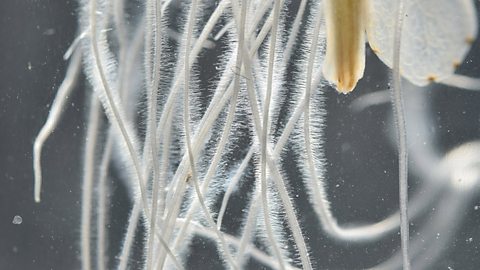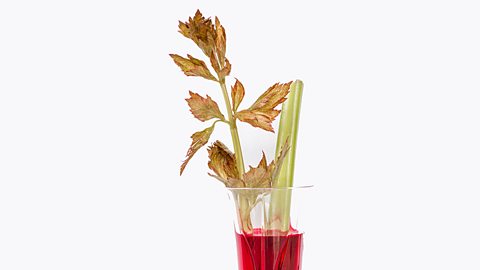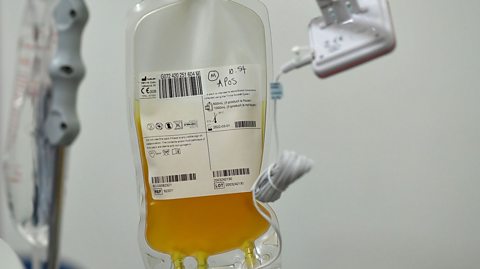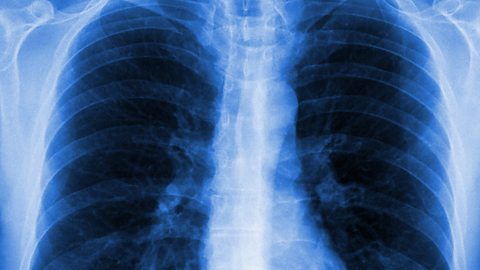Key points
- Cells are the fundamental unit of all living things.
- Specialised plant cells have components that allow them to complete a specific purpose.
- Specialised plant cells include root hair cells, palisade cells, xylem cells and phloem cells.
Video - Specialised plant cells
Learn about specialised plant cells
Just like animals, plants are made of tiny little cells.
Like animal cells, basic plant cells have a nucleus, a cell membrane and cytoplasm. They've also got a vacuole, chloroplasts and a cell wall, which are only found in plant cells and they can be a bit bigger than animal cells.
Plants also have some very specialised cells. Root hair cells don't have light absorbing chloroplast because they don't absorb light because they're underground. What they do have is a wide surface area to more efficiently absorb water and minerals.
Xylem cells lose their end walls so they can form continuous tubes almost like pipes to transport that water up to stems and leaves.Palisade or leaf cells live right beneath the surface of leaves. Like root hair cells they have a large surface area, but they are made of 70% chloroplast to absorb as much sunlight as possible. Which makes them very green and very good at photosynthesis and also very tasty.
Well, sometimes.
Can you answer these questions based on the video?
1. What are the three main components of plant cells?
2. What are the three components of plant cells that are not found in animal cells?
A nucleus, cell membrane and cytoplasm
A vacuole, chloroplasts and a cell wall
Root hair cells

Roots hold plants in place as they grow and also absorb water and minerals from the soil. Roots divide into smaller and smaller branches as they travel into the soil. The outside surface of roots are covered with root hair cells, which have tiny 'hairs' which poke into the soil. This massively increases the surface area for the root hair cell to absorb more water and minerals.

Palisade cells

When the Sun shines, photosynthesisA process in which plants and algae covert light, carbon dioxide and water into glucose and oxygen. in plant cells makes sugar for growth, reproduction and other life processes. Photosynthesis occurs in a special chemical called chlorophyllGreen pigment found within chloroplast that enables the process of photosynthesis to occur., which is found in parts of plant cells called chloroplastStructures found in plant cells which have a green pigment called chlorophyll in them. Photosynthesis occurs here.. Palisade cells are the major site of photosynthesis. They are well adapted for this function because:
- they are towards the tops of leaves for maximum light
- they have lots of chloroplasts

Xylem and phloem cells
- Xylem cells transport water from the roots to other parts of the plant.
- Phloem cells transport sugary water from the leaves to the rest of the plant.
Xylem
Xylem cells run inside stems of plants from their roots to their leaves. Xylem cells die and their ends break down. This allows them to form long tubes to carry water upwards for photosynthesis. They have thick cell walls to provide support to the plant. This holds the leaves up for photosynthesis and the flowers up for reproduction.

Phloem
Phloem cells are often found near to xylem cells in the stem. Unlike xylem cells, phloem cells are alive. They carry sugary water from the leaves to the rest of the plant. Next to the phloem cells are companion cells which have many mitochondriaTiny parts of cells floating in the cytoplasm where energy is released from glucose. The glucose comes from food.. Here respirationA chemical reaction that occurs in the mitochondria of cells in which glucose and oxygen react to produce carbon dioxide and water, releasing energy. occurs to release energy from glucose to transport sugar and other substances in the phloem.
Test your knowledge
Quiz
Test questions
Write a paragraph to answer each of the following questions. Tap 'Show answer' to see some points you could have included.
Describe the adaptations of root hair and palisade cells.
- Root hair cells have tiny 'hairs' which poke into the soil. These massively increase the surface area to absorb more water and minerals.
- Palisade cells are the major site of photosynthesis. They have many chloroplasts in which photosynthesis occurs.
- They are found towards the tops of leaves to absorb maximum light.
Describe the purpose and adaptations of xylem and phloem cells.
- Xylem cells carry water from roots to leaves.
- Xylem cells are dead with broken down ends to form tubes.
- Xylem cells have strong walls to hold the stem upright.
- Phloem cells carry sugary water from the leaves to the rest of the plant.
- Phloem cells are alive.
- Phloem cells have companion cells with lots of mitochondria to provide energy.
Play the Atomic Labs game! gamePlay the Atomic Labs game!
Try out practical experiments in this KS3 science game.

More on Living organisms
Find out more by working through a topic
- count4 of 15

- count5 of 15

- count6 of 15

- count7 of 15
